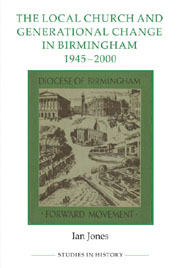Book contents
- Frontmatter
- Contents
- List of figures and tables
- Acknowledgements
- Abbreviations
- Map of Birmingham
- Introduction
- 1 Birmingham: the city and its churches
- 2 The spectre of ‘decline’
- 3 Church, youth and family from the 1940s to the 1960s
- 4 Life and worship in the local congregation
- 5 Church and neighbourhood: four congregational stories
- 6 Towards the margins: being Christian in a pluralist society
- Conclusion
- Appendix: Oral history
- Bibliography
- Index
Conclusion
Published online by Cambridge University Press: 05 February 2013
- Frontmatter
- Contents
- List of figures and tables
- Acknowledgements
- Abbreviations
- Map of Birmingham
- Introduction
- 1 Birmingham: the city and its churches
- 2 The spectre of ‘decline’
- 3 Church, youth and family from the 1940s to the 1960s
- 4 Life and worship in the local congregation
- 5 Church and neighbourhood: four congregational stories
- 6 Towards the margins: being Christian in a pluralist society
- Conclusion
- Appendix: Oral history
- Bibliography
- Index
Summary
Amidst the flurry of recent debate about secularisation and religious change in postwar Britain, comparatively little attention has been paid to the experience of those who swam against the cultural tide and continued to belong to local churches. This study, rooted in both documentary and original oral history research has sought to redress that imbalance through an exploration of church-based Christianity in postwar Birmingham. In exploring how churchgoers interpreted and responded to the changes that they saw in family, congregation, neighbourhood and wider society, an attempt has been made to begin to provide for the post Second World War period the kind of in-depth historical investigation of grass-roots Christian belief and practice that has so enriched our understanding of other historical periods. Admittedly, any foray into new historical territory raises as many questions as it answers. The history of the relationship between Christianity and English culture in the late twentieth century is growing up fast but is yet to attain its majority. However, this local church perspective has confirmed the potential significance to our understanding of religious change of major shifts in family life and religious socialisation, changing assumptions about public duty and the regulation of personal behaviour and new patterns of leisure.
- Type
- Chapter
- Information
- Publisher: Boydell & BrewerPrint publication year: 2012

